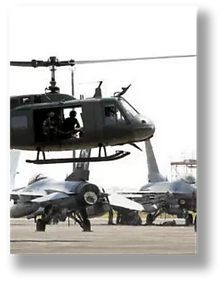.png)


MISSION COMMAND

-
A leadership philosophy and a command and control approach that emphasizes decentralized execution based on a clear understanding of the commander's intent.
-
Empowers subordinate leaders to exercise disciplined initiative to achieve mission objectives. The approach moves away from rigid, unit-centric methods towards a collaborative environment that prioritizes broader organizational goals and interoperability.
-
Aims to foster adaptability, innovation, and strategic foresight within the organization.
-
The core idea is to achieve an effective and adaptive force capable of responding to evolving threats and national security challenges through highly effective leadership approaches supported by a skilled and motivated organization through targeted leadership and competency development at all levels.
Elements of PAF Mission Command


Principles
Centralized Command
This refers to the strategic direction set at the highest levels, where the overall intent, vision, and broad objectives are established. This is where the "Basis" (B in BAGWIS) originates, providing the guiding blueprint for the entire organization.

Distributed Control
This signifies the delegation of authority for planning, coordination, and resource management to various echelons and functional areas. It's about ensuring coherence and alignment across units without micromanagement, allowing for effective management and direction of forces.

Decentralized Execution
This is the practical application of Mission Command, empowering subordinate leaders to exercise disciplined initiative and make decisions within the commander's intent at the point of action. This fosters adaptability and innovation.

Shared Accountability
This vital element encircles the command and control principles, emphasizing that while execution is decentralized, all levels share responsibility for achieving the mission and upholding standards. This ensures consistency and trust across the organization.

Pillars
The pillars of mission command are expected to contribute to and be reciprocally supported by the principles of mission command. These pillars radiate from the central tenets, showing their interconnectedness and comprehensive nature.
B - Basis (Blueprint / Strategic Direction & Shared Understanding)
This pillar is about establishing the foundational plan, defining the overarching intent, and ensuring a shared understanding of the mission. It includes the PAF's Vision and the clear communication of strategic objectives. This helps overcome unit-centric approaches by fostering organizational goal prioritization.

A - Adaptability (Prudence, Innovation & Resilience)
This pillar represents the organization's capacity to respond effectively to dynamic environments through sound judgment, innovation, and resilience. It involves integrating traditional command with transformational leadership to foster foresight and continuous adjustment. Key competencies include Self-Management and Resilience, Consequential Thinking, Scenario Planning, and Managing Risks.

G - Growth (Leader Development & Competency Building)
This pillar focuses on the continuous cultivation of proficiency, skills, and character across all leadership levels. It encompasses the entire leader development framework, from foundational training to advanced career courses, ensuring measurable gains in individual and team competencies. It addresses the ambiguous connection between leadership and competency development.

W - Weave (Interoperability, Interconnectedness, Collaboration & Synergy)
This pillar emphasizes the integration of efforts across units and echelons to achieve collective effectiveness. It fosters a collaborative culture, builds trust, and empowers teams through strong interpersonal relationships and strategic partnerships, embodying the spirit of "Pakikisama". Competencies like Building Effective Teams, Relationship Management, and Designing Strategic Collaborations are crucial here.

I - Impact (Performance, Accountability & Results)
This pillar represents the translation of all efforts into measurable outcomes, sustained performance, and accountability. It highlights the importance of enhancing feedback mechanisms and establishing systems for tracking effectiveness to ensure that leadership truly drives results. Performance Management is a key competency.

S - Stewardship (Responsible Leadership & Ethical Governance)
This pillar signifies upholding trust, exercising authority ethically, and managing resources prudently for the long-term benefit and future of the organization. It reinforces the "Vision and integrity-driven air force" and involves cultivating core values and responsible decision-making, including policy appreciation, formulation, analysis, and execution.

What the PAF Mission Command is not:
-
It is not simply the delegation of a higher commander’s position or permission to execute their responsibilities. While authorities can be delegated through proper channels, responsibility cannot be delegated.
-
It is not a grant of command authority outside of legal boundaries. The philosophy of mission command does not grant leaders authority to execute missions or make decisions outside of their commander’s legal authorities.
-
It is not the approval to ignore established doctrinal practices and tactics, techniques, and procedures (TTPs). Mission command is not a license to ignore the commander’s intent or take unauthorized or unnecessary risks.
-
It is not simply the result of issuing orders or commands. PAF Mission Command is a fundamental shift in the character of command. It shifts from a hierarchical and directive approach to a reciprocal and implicitly collaborative one.
-
It is not achieved without developing a command climate of mutual trust and respect. Without established trust, staff may implement more reporting and control measures. PAF Mission Command actively fosters a collaborative culture, trust, and smooth interpersonal relationships. This ensures an environment where distributed control and decentralized execution thrive, and an unprepared staff is developed to operate within a mission command construct of trust, shared understanding, intent, and empowerment.
-
It is not the approval to distribute control to an incapable or inappropriate level. Control inherently implies the ability to plan, coordinate, execute, and assess air operations with sufficient staff, expertise, resources, and effective communication.
-
It is not applied in all situations. Specific missions and operations are not suited to a decentralized approach, especially where consistency and uniformity are required. Commanders may retain authorities to reduce strategic risk or preserve resources, or when subordinates lack the necessary ability, knowledge, information, or awareness to make decisions.